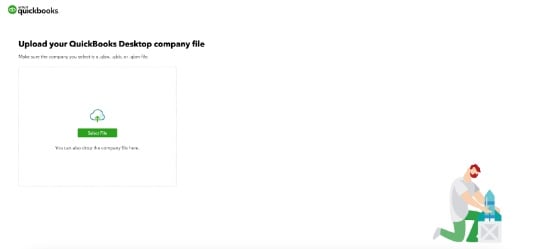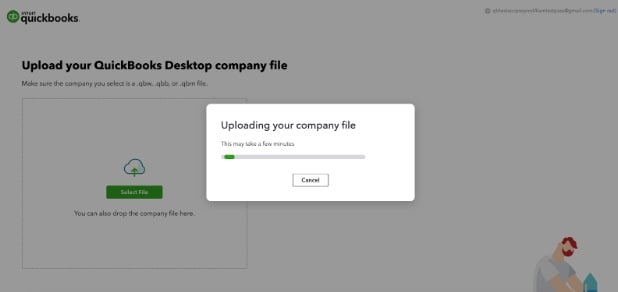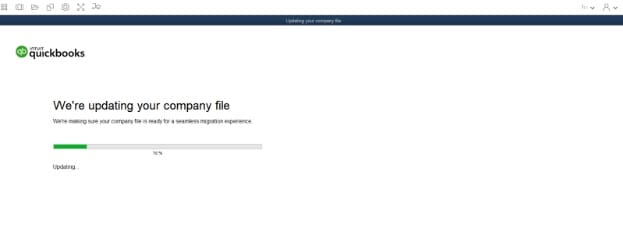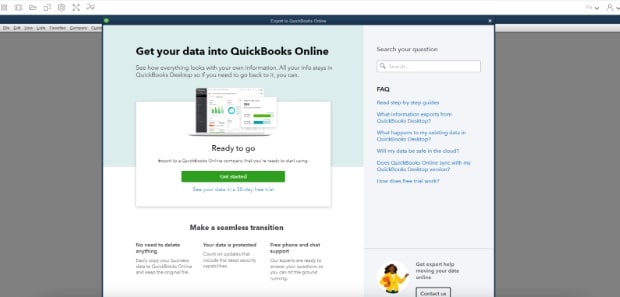Move your QuickBooks Desktop file to QuickBooks Online
by Intuit•20• Updated 2 days ago
To move your data from QuickBooks Desktop to QuickBooks Online account, you first need to prepare your desktop company file. You can then migrate your data using either the tool within QuickBooks Desktop or the web-based migration tool. After the migration, you will need to complete the setup in your new QuickBooks Online company.
If you’re not sure which QuickBooks Online is right for you, check out these resources:
Note: You have 60 days from the time you create your QuickBooks Online account to move your data. If you’re not sure how old your company is, sign in to QuickBooks Online. Then, refresh this page for personalized info.
To learn more about names and what transfers, check out our comparison article.
What you'll need
To get started with your migration, you’ll need:
- An active QuickBooks Online account in the same county or region as your QuickBooks Desktop account.
- The latest release of QuickBooks Desktop.
- A file with under 4,000,000 links between transactions. Check the number of links in your file using the F2 key or Ctrl+1.
- Admin access to both your Desktop company file and your QuickBooks Online account.
- A printed or saved copy of your Sales Tax Report.
- If you use online banking, categorize and reconcile all bank and credit card transactions.
- If you use QuickBooks Desktop Payroll, make sure all team member profiles are correct. Terminate or deactivate any team members who haven’t been paid this year, and wait 2-3 days after running payroll to move your data. Make sure to move your data at least a few days before your next payroll run.
- If you use QuickBooks Time, contact support for assistance in setting up your account in QuickBooks Online.
Move your QuickBooks Desktop file to QuickBooks Online
You have two options to move your data.
| Important: If your QuickBooks Desktop version is 2021 or older or you don’t have access to QuickBooks Desktop, you'll have to use the web-based migration tool. |
- Sign in as an admin in QuickBooks Desktop.
- Export your QuickBooks Desktop company:
- In QuickBooks Desktop Pro and Premier, go to Company and select Export Your Company File to QuickBooks Online.
- In QuickBooks Desktop Enterprise, press CTRL + 1 to open the Product information window. Then press CTRL + B + Q then select OK.
- Select Get started.
- You’ll see the "Let’s bring your data to QuickBooks Online" screen. Select how you want to move your data:
- Bring all of your company data.
- Bring only lists and balances. (This option is helpful if you have a large file and don’t want to bring over every individual transaction).
- Select Continue.
- If you have inventory, you can:
- Select Yes, track inventory using FIFO then select a starting date.
- Select No, don’t move inventory. You can move your inventory manually later.
- If you use multi-currency in QuickBooks Desktop, you’ll have to select a home currency.
- Select Continue.
- You will be asked if you have a QuickBooks Online account.
- If you do, select Yes, sign me in, then select Continue.
Note: This is the account you created when you purchased your QuickBooks Online solution in Step 1 Subscribe to QuickBooks Online. - If you have not selected a QuickBooks Online solution, you can select No, I need to create one. This will create a QuickBooks Online Advanced trial company. We recommend you go to Quickbooks.intuit.com/ca/ to buy the right QuickBooks Online version for your company before starting migration.
- If you do, select Yes, sign me in, then select Continue.
- On the next screen, you will be asked to sign in. Sign in using the same user ID and password associated with your QuickBooks Online subscription.
- You’ll see your QuickBooks Online company names and subscriptions listed. Select the company you want to move your data to.
- Select Continue, then select Export. You will see a progression bar as your data is moved over to QuickBooks Online.
Note: If you already have data in a QuickBooks Online account, QuickBooks will ask if you want to replace the existing data, follow the below steps. - Turn on the toggle switch I want to replace existing Quickbooks Online data with data from QuickBooks Desktop.
Online migration tool
Use this option if:
- You have QuickBooks Desktop 2021 or older
- You don’t have access to QuickBooks Desktop
Note: Check out Learn how features and data move from QuickBooks Desktop to QuickBooks Online article to see what moves to QuickBooks Online.
Step 1: Open the online tool
- Select the link for your QuickBooks version (available in English only):
- Select Get started, then sign in with your Intuit Account.
Step 2: Upload your company file
Follow these steps to upload your company file.
- Select Select File, then browse to the supported QuickBooks Desktop file you want to move.
Note: You can only upload one file at a time.

- Select Open to upload the file or drag and drop your QuickBooks Desktop file to upload it.

- Once your file is uploaded, we’ll auto-update it to the latest version of QuickBooks Desktop.

- Next, you'll see an option to move to QuickBooks Online.
- Follow the on-screen instructions to guide you through the move to QuickBooks Online.

- If your books fail to update to QuickBooks Desktop or move to QuickBooks Online, contact customer support.
Results
Your QuickBooks Desktop company data, or your selected lists and balances, is now available in your QuickBooks Online account.
Next steps
To learn more about your Home Dashboard click here.
Follow this list of what to set up in your new QuickBooks Online company.
- Schedule a 45 minute call with one of our experts. We'll answer questions about your data move, show you around QuickBooks Online, and help you tackle everyday tasks.
- Get started with QuickBooks Online and Get started and adjust settings after you sign up for QuickBooks Online.
- Connect your bank or credit card account.
- Create and send invoices to your customer.
Note: If you track sales tax, set up location-based sales tax in QuickBooks first. - Track your bills and learn how to pay them in QuickBooks.
- If you use payroll, check our article Get started with QuickBooks Online Payroll to help you set up and run your payroll in QuickBooks Online.
Related articles
More like this
- Move or reinstall QuickBooks Desktop to another computerby QuickBooks
- Move your company files to another computerby QuickBooks
- How to set up QuickBooks Desktop to work from homeby QuickBooks
- Can't open company file in QuickBooks Desktopby QuickBooks